Roaring Lions and Ferocious Pugs of the Postwar
Era: 1:64 scale Peugeots, 1945-2002
by Brian Willoughby, images by Doug Breithaupt |
Founded in 1889, Peugeot is not only the oldest automobile manufacturer
in France, it is also one of the oldest car makers in the world. Founded
by the Peugeot family as a bicycle company, it remains, to this day, one
of a handful of automobile companies still controlled by a single family.
Its early history was punctuated with innovative designs that easily equaled
those produced by a competing (and very slightly older) company in neighboring
Germany. Peugeot's prewar designs were often innovative and stylish, culminating
in the impressive 402 of 1935 that exhibited a heavy echoes of American
'art deco' streamlining.
Peugeot's first postwar car, the 203 carried a fastback body style that
once again showed a great deal of American influence. First available in
1948, the 203 followed the typical Peugeot practice of keeping a chassis
in production for several years after its replacement appeared: the new,
Pininfarina-bodied 403 arrived during 1955 yet the old school 203 remained
in production until 1960. Expanding their product range, Peugeot introduced
404 for 1960 and concurrently ran it alongside the older 403 for six years.
Obtaining the maximum mileage out of a chassis, the 404 continued to roll
off of Pug's production lines for seven years after the new 504 made its
debut in 1968. In between the big Pugs, some especially competent small,
front-wheel drive Peugeots, including the 204 and 304, brightened the usually
dark world of economy cars.
With its quality automotive products, Peugeot has always been able to
survive when those around it failed. Over the years, Peugeot has grown into
one of the world's largest auto producers. Its capacity was increased dramatically
by its purchase of rival French auto maker Citroen in 1974 and was further
augmented by its takeover of Chrysler Corporation's European facilities
(Simca and Talbot in France and the remains of the old Rootes Group in the
United Kingdom) during 1978. Seemingly, Peugeot was poised to extend its
presence throughout the world; however, it was never able to muster much
of a following in the one market that seems to matter the most.
The final Peugeots sold in the U.S. and Canada were the 405 and 505 and
its departure during the early 1990s from North America left France without
a single representative on the world's largest automobile market. Peugeot
has been said to be considering a return and has even been rumored to have
been seeking a potential site to build a North American production facility.
A review of Peugeot's current offerings makes many new car buyers regret
the brand's absence. Nonetheless, toy Peugeots are fortunately still being
sold throughout the world. Let's take a look at what has been produced in
1:64 scale diecast models since the end of the Second World War.
404
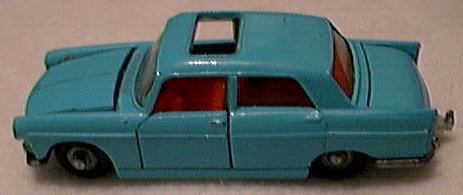 Commencing a continuing tradition of handsome and understated
Pininfarina styling among Peugeot's large sedans, the 404 was a robust and
solid machine that proved its metal through a highly successful rallying
career throughout the 1960s. In spite of its many championships on the rally
course, the 404 sedan was largely ignored in 1:64 scale and only a single
miniature made its debut from an unexpected source: Lone Star's Impy range.
Happily, Impy's 404 is a diecast tour de force: including an operational
bonnet, front doors and boot, the only spoiling factor for this miniature
are unfortunately loud color selections. Majorette followed another path
with its 404 and gave the 1:64 scale diecast world its only Peugeot estate
car to date. Decorated in several liveries including those of civilian,
police and paramedics, Majorette's 404 wagon featured an operational tailgate
in addition to the somewhat obligatory opening bonnet and front doors that
had been mandated by other early models offered by this manufacturer.
Commencing a continuing tradition of handsome and understated
Pininfarina styling among Peugeot's large sedans, the 404 was a robust and
solid machine that proved its metal through a highly successful rallying
career throughout the 1960s. In spite of its many championships on the rally
course, the 404 sedan was largely ignored in 1:64 scale and only a single
miniature made its debut from an unexpected source: Lone Star's Impy range.
Happily, Impy's 404 is a diecast tour de force: including an operational
bonnet, front doors and boot, the only spoiling factor for this miniature
are unfortunately loud color selections. Majorette followed another path
with its 404 and gave the 1:64 scale diecast world its only Peugeot estate
car to date. Decorated in several liveries including those of civilian,
police and paramedics, Majorette's 404 wagon featured an operational tailgate
in addition to the somewhat obligatory opening bonnet and front doors that
had been mandated by other early models offered by this manufacturer.
 204
204
As with a number of other small scale Peugeots, the 204 is represented
by a single model produced by a French diecaster. Rarely does the word 'cute'
seem appropriate when describing a model car; however, in the case of Majorette's
204 C Cabriolet, hardly a more apt description can be found. A rare and
charismatic miniature, the 204 C Cabriolet features a delicate windscreen,
a nicely detailed interior and opening doors. Earlier versions of this little
charmer arrived with more accurate wheels and paint color choices; nonetheless,
all varieties of this miniature are difficult to track down.
504
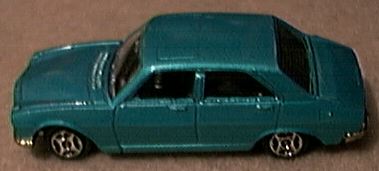 Strangely associated with the primitive road networks of
former French colonies as well as North American university faculty parking
lots, the 504 was the archetypical Peugeot sedan of the early 1970s. One
of Peugeot's longest running models, the 504 was styled by Pininfarina yet
only ranked a paltry pair of miniatures produced by Majorette and Norev.
Nevertheless, the few 504 offerings made up for their meager numbers with
outstanding quality and Majorette's model of the big Pug has to rate as
one of the brand's all-time best miniatures while Norev's 504 perfectly
captures its unique Gallic charm. Equipped with an amazing suite of operating
features for a 1:64 scale model (bonnet, front doors and boot), a complete
and mint example of Majorette's 504 is a rare and frequently expensive find
on today's antique toy market. Likewise, Norev's miniature can present a
challenge to modern collector's and while it is a much simpler casting,
it makes a very worthy addition to anyone's collection of toy Peugeots.
Strangely associated with the primitive road networks of
former French colonies as well as North American university faculty parking
lots, the 504 was the archetypical Peugeot sedan of the early 1970s. One
of Peugeot's longest running models, the 504 was styled by Pininfarina yet
only ranked a paltry pair of miniatures produced by Majorette and Norev.
Nevertheless, the few 504 offerings made up for their meager numbers with
outstanding quality and Majorette's model of the big Pug has to rate as
one of the brand's all-time best miniatures while Norev's 504 perfectly
captures its unique Gallic charm. Equipped with an amazing suite of operating
features for a 1:64 scale model (bonnet, front doors and boot), a complete
and mint example of Majorette's 504 is a rare and frequently expensive find
on today's antique toy market. Likewise, Norev's miniature can present a
challenge to modern collector's and while it is a much simpler casting,
it makes a very worthy addition to anyone's collection of toy Peugeots.
604
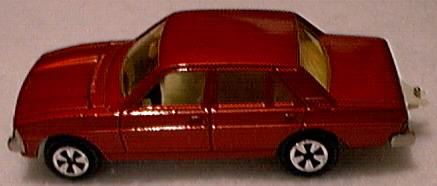 Peugeot's range topping model during the late 1970s and early
1980s, the opulent 604 was initially the showcase for the new Peugeot-Renault-Volvo
V6; however, a turbocharged diesel eventually augmented the choice of available
power plants. Never developing into the prestigious model that Peugeot had
hoped for, the 604 lingered for several seasons as painful reminder of what
might have been. Following the pattern set by the 504, only Majorette and
Norev tooled up to produce miniatures of the 604: Majorette's model featured
an opening hood yet rode slightly too high on its suspension while presenting
an incorrect rear wheel cut-out shape that was too rounded. Norev's miniaturized
version of the top-of-the-line Pug was, once again, simpler and offered
no operating gimmicks; nevertheless, it readily managed to present both
the car's correct ride height and wheel well proportions.
Peugeot's range topping model during the late 1970s and early
1980s, the opulent 604 was initially the showcase for the new Peugeot-Renault-Volvo
V6; however, a turbocharged diesel eventually augmented the choice of available
power plants. Never developing into the prestigious model that Peugeot had
hoped for, the 604 lingered for several seasons as painful reminder of what
might have been. Following the pattern set by the 504, only Majorette and
Norev tooled up to produce miniatures of the 604: Majorette's model featured
an opening hood yet rode slightly too high on its suspension while presenting
an incorrect rear wheel cut-out shape that was too rounded. Norev's miniaturized
version of the top-of-the-line Pug was, once again, simpler and offered
no operating gimmicks; nevertheless, it readily managed to present both
the car's correct ride height and wheel well proportions.
305
Represented by a single 1:64 scale miniature, an elegant model of Peugeot's
mid-range 305 was generated by Norev. As with most other Norev Mini Jets
castings, the Peugeot 305 was a rudimentary yet highly effective toy car
that reveals itself, upon close examination, to be both a highly accurate
and detailed miniature of an otherwise forgotten car that other diecast
manufacturers failed to bother themselves with. .
505
Although it was no surprise to find Norev offering a model of the new
505, it was curious to note that this handsome sedan also attracted the
attention of Siku and Hot Wheels. By far the most engaging small scale 505
was Siku's miniature: featuring opening front doors, it simply and effectively
captured the actual car's difficult to depict stance better than any of
the competition. Despite its noteworthy accuracy, Norev's 505 readily appeared
as dull and lackluster as any large, European family sedan could. A highly
unlikely model for Hot Wheels, Mattel's Peugeot 505 illustrated that it
could offer a sedate, scale model for a change; however, who could have
imagined the 505 as a hopped-up hot rod to begin with?
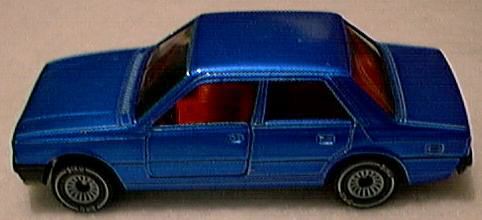
505 STI - Siku #1043 |
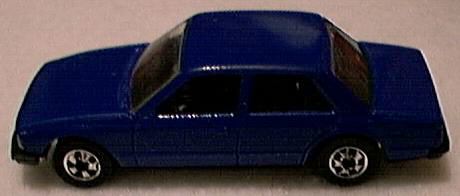
505 - Hot Wheels |
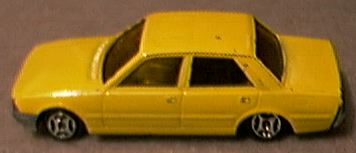
505 SR - Norev |
205 and 205 Turbo
After allowing its range of small cars to grow somewhat dull and long-in-the-tooth,
Peugeot unveiled a class-leading product with its distinctively styled 205.
Setting its sights on toppling Volkswagen's Golf, the 205 proved itself
to be one of the most desirable hatchbacks on the market, and, in Gti form,
a 'hot hatch' to be reckoned with. Although the American automotive press
begged for Peugeot to certify the 205GTi for U.S. sales, this very sporting
little Pug was strangely never exported for sale there. Perhaps Peugeot
would have finally found a permanent niche with this car rather than having
to eventually abandon the North American market as too costly to compete
upon. Fortunately, the appeal of this car was not lost on diecast car scene
and a few miniatures were offered by one of the usual suspects and, at the
time, a new upstart. Majorette's 205 typifies this brand of quality miniatures:
well-constructed with a cast body and base, this model features detailed
plastic interior molding as well as a novel opening rear hatch. Majorette
also offered the cabriolet version of the 205. The CTi clearly was designed
to compete with the Golf cabrio. Siku also did the CTi with their usual
sturdy charm. Beginning its life under the MC Toy brand name, Maisto's 205GTi
illustrated that this company was quickly evolving away from producing pirated
models to generating original tools of their own design. While not a particularly
engaging miniature in regard to its play value, Maisto 205 was accurate
and little spunky--just like the actual car. A generic 205 in fire car trim
was produced in China. Guisval of Spain produced a 205, complete with rally
tampos and opening doors.
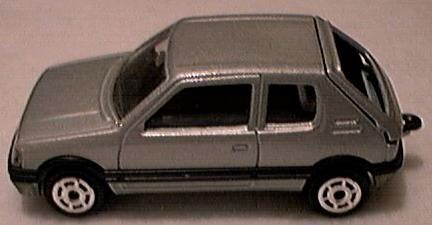
205 GTi -Majorette #281 |
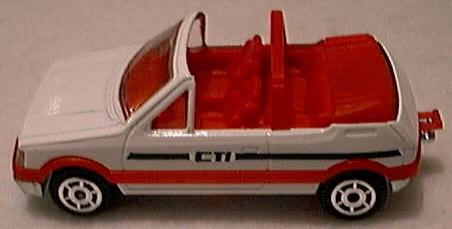
205 CTi - Majorette # |
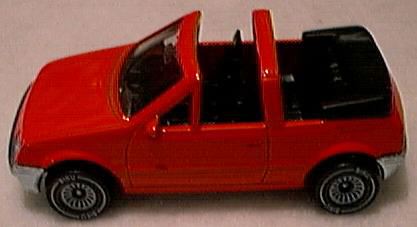
205 CTi - Siku #1071 |
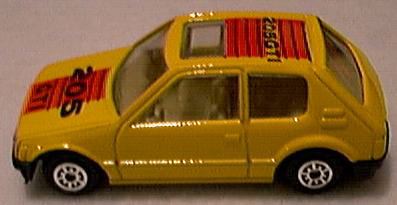
205 GTi - Maisto |
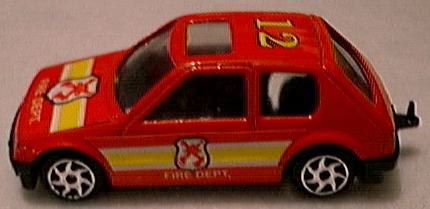
205 Fire Car - generic |
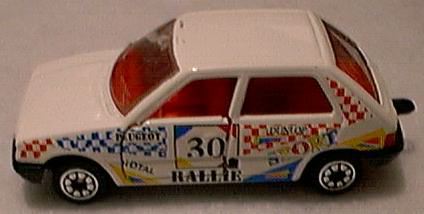
205 - Guisval |
405
By the time that the 405 made its debut upon the automobile market, the
diecast world had witnessed the demise of a myriad of once well-established
brand names. Perhaps most notable within the world of French vehicles was
Norev's discontinuation of the Mini Jet range since it had documented the
French automotive industry more thoroughly than any other single brand.
With the Mini Jets departure, it was up to Majorette to continue to issue
miniatures of notable French cars that the rest of the diecast industry
avoided like the plague. Majorette's model of the high-performance 405 MI
16 sedan depicted the fun and sporty nature of this car well while adding
functional front doors to the package. Oddly, Hot Wheels also produced a
405 miniature; a static model that appeared both in stock and as a rally
version. It was apparently only made available in an attempt by Mattel to
further penetrate the toy market France as its overall appeal was severely
limited elsewhere.
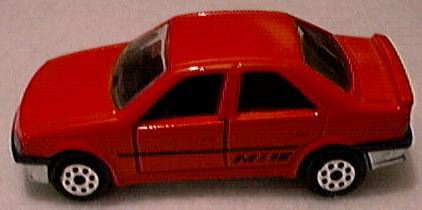
405 M1 16 - Majorette #218 |
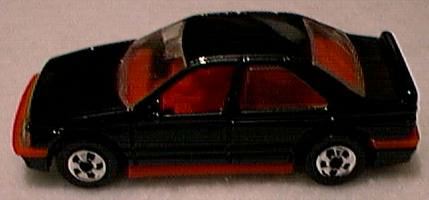
405 - Hot Wheels |
|
205 T16 and 405 T16
Attracting an unusual amount of attention for such a discreet automaker
during the mid- to late 1980s was Peugeot's triumphant 205 T16 and 405 T16
rally cars. Based on the same chassis underpinnings, these vehicles were
designed to be consistently victorious in grueling off-road rally events
such as the famed Paris-Dakar. Where other diecast makers had sold miniaturized
versions of the 205 Turbo production car, only Hot Wheels geared up a miniature
of the 205 T16: named 'Peugeot 205 Rallye', the model's rear body was hinged
and opened to reveal the car's rear-mounted, turbocharged engine. Matchbox
conjured up a miniature version of the four-wheel-drive and mid-engined
205 Turbo 16 that was fitted with an opening rear body. Not a member of
the North American model assortment, this toy Peugeot can be a challenge
for collectors to locate today.Much more popular among toy car specialist
was the 405 T16 and no less than three 1:64 scale models of this car appeared.
With a rakish body that showed little relation to the production 405, the
T16 was a natural subject for Majorette whose accurately shaped model of
the car features a massive rear spoiler and tampo printed sponsor logos
covering the body. Having never produced a Peugeot miniature before did
not deter Zylmex from tooling up one of its best models of 1990s: the only
detractions from Zee Toys 405 T16 are its simplistic interior molding and
ugly wheels and odd colors. Finally, Maisto, in an uninspired moment, somehow
presented a miniature of the T16 that appeared so tame, it would have looked
at home in the parking lot of a Safeway or Piggly Wiggly. Edocar of Holland
also offered the Maisto casting in their line as #23. It make the Maisto
version look racy as Edocar used a stock paint color.
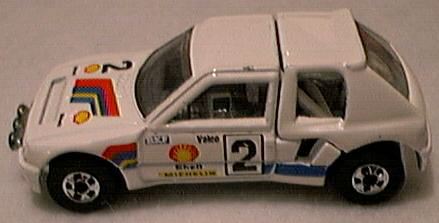
205 T16 - Hot Wheels |
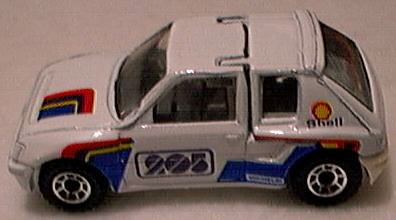
205 T16 - matchbox |
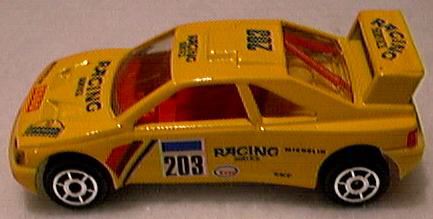
405 T16 - Majorette #202 |
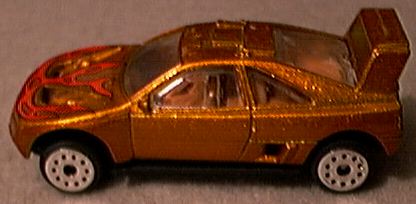
405 T16 - Zylmex #D117 |
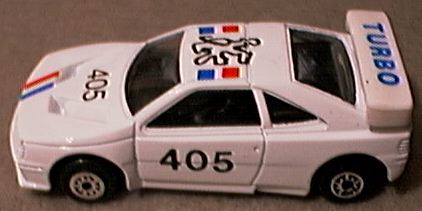
405 T16 - Maisto |
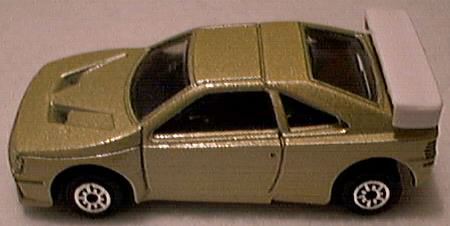
405 T16 - Edocar #23 |
605
Less angular than its predecessor, Peugeot's new top drawer offering
was named, logically enough, the 605. Drawing on the popular organic styling
trends then beginning to dominate the automotive world, the 605 once again
attempted to lure car buyers away from BMWs and Volvos and into a big and
luxurious Peugeot; however, the 605 would prove to be as equally unsuccessful
at seriously competing within this bracket as the previous 604 had been.
Portugal's Novacar stepped up to present a miniature of the 605. A now defunct
brand that was absorbed by Majorette, the 605 was constructed in the typical
Novacar fashion with a plastic body molding and a diecast base. Guisval
of Spain did a coupe version of the 605 and Yat Ming offered what appears
to be a crude 605 as #815.
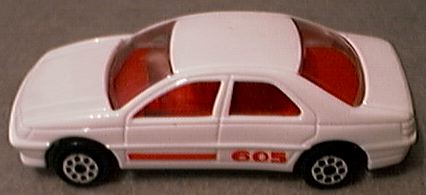
605 - Novacar - #106 |
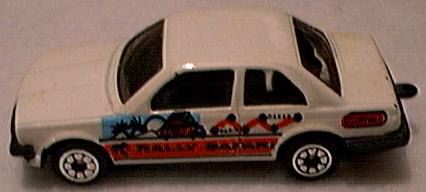
605 Coupe - Guisval |
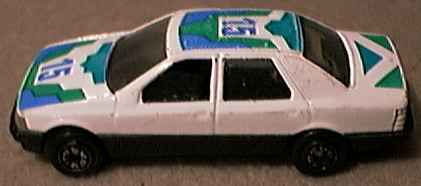
605 - Yat Ming #815 |
 Quasar
Quasar
A show car intended to highlight Peugeot's latest technological advancements,
the Quasar was equipped with four-wheel drive and one of the most exotic
bodies ever to grace a Pug chassis. Having rarely paid any homage to Peugeot,
Matchbox opted to produce a well-detailed miniature of the Quasar prototype
complete with a chromed engine and interior and bold graphics. Although
it was sold in five different series and numerous color variations, the
ubiquitous Quasar barely compensated for Matchbox's neglect of other Peugeot
cars over the years.
309
 Bread-and-butter cars are infrequently the
subject of diecast miniatures since, while they are typically solid sellers
to the car-buying public, they possess limited 'flash' and consequently
low appeal to both children and the majority of collectors. Although the
309 hatchback clearly fell into this realm of boring family cars, its breaking
with the time-honored and standard Pug nomenclature did indicate that it
was a slightly different Peugeot. The '09' designation during a time when
all other Peugeots were being assigned '05s' signaled that this particular
car was manufactured at the old Rootes Group facility in England; Peugeot
had inherited this factory when it bought out Chrysler's United Kingdom
operations during 1978. Despite the fact that the 309 was largely a mundane
family car outside of its rather convoluted history, Maisto still created
a nicely detailed miniature of this mid-size Pug so that kids could have
a toy car that looked 'just like dad's.'
Bread-and-butter cars are infrequently the
subject of diecast miniatures since, while they are typically solid sellers
to the car-buying public, they possess limited 'flash' and consequently
low appeal to both children and the majority of collectors. Although the
309 hatchback clearly fell into this realm of boring family cars, its breaking
with the time-honored and standard Pug nomenclature did indicate that it
was a slightly different Peugeot. The '09' designation during a time when
all other Peugeots were being assigned '05s' signaled that this particular
car was manufactured at the old Rootes Group facility in England; Peugeot
had inherited this factory when it bought out Chrysler's United Kingdom
operations during 1978. Despite the fact that the 309 was largely a mundane
family car outside of its rather convoluted history, Maisto still created
a nicely detailed miniature of this mid-size Pug so that kids could have
a toy car that looked 'just like dad's.'
406
Replacing the 405, the attractive 406 debuted during the mid-1990s and
eventually superseded not only its direct predecessor yet also the elderly
505 as well. Like the 405, 504 and 505 before it, the 406 range attempts
to provide something for everyone including a handsome coupe with lines
drawn by Pininfarina. One of many Peugeots denied Americans over the years,
the only way to own a 406 in the U.S. is to locate a miniature of the car.
Seemingly also withdrawn from U.S. distribution, Majorette has created some
interesting diecast 406 sedan variations that include both civilian and
police versions. Yet most collectors will prefer Welly's new casting of
the 406 Coupe that is just as desirable in small scale as it is in full
size.
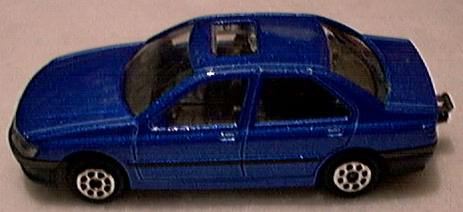
406 - Majorette #218 |
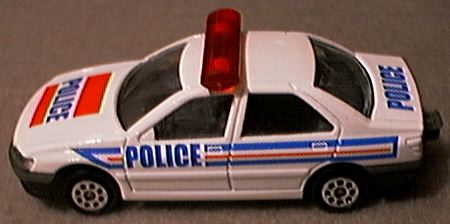
406 Police - Majorette #222S |
|
206
 To replace the widely admired and legendary 205, Peugeot
had to make every effort to ensure that the 206 would be a worthy successor.
Proving that Peugeot can design small hatchbacks that are as equally fun,
sophisticated, stylish and desirable as Volkswagen's benchmark Golf, the
new 206 seems to have easily hit its target. As might have been anticipated,
Majorette, the only surviving French-based brand of 1:64 scale toy vehicles
was quick to produce a thoughtfully detailed 206 that looks as good as the
real car. After years of offering pirated castings copied from ancient tools
and dies, it may come as a surprise to some old-time collectors to find
that Welly is now making a wide range of 1:64 scale models that are both
a great value in addition to being some of the best and most accurate miniatures
currently on the market. For evidence, look no further than Welly's Peugeot
206s: the standard 206 hatchback rivals Majorette's and the 206 CC convertible
a unique and enticing model of the type that many collectors would enjoy
seeing more of.
To replace the widely admired and legendary 205, Peugeot
had to make every effort to ensure that the 206 would be a worthy successor.
Proving that Peugeot can design small hatchbacks that are as equally fun,
sophisticated, stylish and desirable as Volkswagen's benchmark Golf, the
new 206 seems to have easily hit its target. As might have been anticipated,
Majorette, the only surviving French-based brand of 1:64 scale toy vehicles
was quick to produce a thoughtfully detailed 206 that looks as good as the
real car. After years of offering pirated castings copied from ancient tools
and dies, it may come as a surprise to some old-time collectors to find
that Welly is now making a wide range of 1:64 scale models that are both
a great value in addition to being some of the best and most accurate miniatures
currently on the market. For evidence, look no further than Welly's Peugeot
206s: the standard 206 hatchback rivals Majorette's and the 206 CC convertible
a unique and enticing model of the type that many collectors would enjoy
seeing more of.
Thus concludes our survey of small scale Peugeots. Although a rightly
number of 1:64 scale Peugeots have appeared over the years, their variety
in no way reflects the number of different vehicles the company produced
during the same time period. For every Pug that was reproduced in miniature,
two, three or more were neglected and it is doubtful that any of the currently
active 1:64 scale diecast manufacturers will take the retrograde step of
filling the many gapping holes in the company's history. Of Peugeot's older
models, only one immediately comes to mind as something that perhaps one
diecast brand might replicate: Detective Columbo's 403 Decapotable would
be a most welcome and extremely worthy addition to Johnny Lightning's 'hollywood
on Wheels' series.
References:
Georgano, G. N. The Complete Encyclopedia of Motorcars, 1885 to the Present.
New York: E. P. Dutton and Company, Inc.
Robson, Graham. The A-Z of Works Rally Cars. Bideford, Devon, England: Bay
View Books Ltd.
Ruiz, Marco. One Hundred Years of the Automobile, 1886-1986. NewYork: Gallery
Books.
www.peugeot.com
 Commencing a continuing tradition of handsome and understated
Pininfarina styling among Peugeot's large sedans, the 404 was a robust and
solid machine that proved its metal through a highly successful rallying
career throughout the 1960s. In spite of its many championships on the rally
course, the 404 sedan was largely ignored in 1:64 scale and only a single
miniature made its debut from an unexpected source: Lone Star's Impy range.
Happily, Impy's 404 is a diecast tour de force: including an operational
bonnet, front doors and boot, the only spoiling factor for this miniature
are unfortunately loud color selections. Majorette followed another path
with its 404 and gave the 1:64 scale diecast world its only Peugeot estate
car to date. Decorated in several liveries including those of civilian,
police and paramedics, Majorette's 404 wagon featured an operational tailgate
in addition to the somewhat obligatory opening bonnet and front doors that
had been mandated by other early models offered by this manufacturer.
Commencing a continuing tradition of handsome and understated
Pininfarina styling among Peugeot's large sedans, the 404 was a robust and
solid machine that proved its metal through a highly successful rallying
career throughout the 1960s. In spite of its many championships on the rally
course, the 404 sedan was largely ignored in 1:64 scale and only a single
miniature made its debut from an unexpected source: Lone Star's Impy range.
Happily, Impy's 404 is a diecast tour de force: including an operational
bonnet, front doors and boot, the only spoiling factor for this miniature
are unfortunately loud color selections. Majorette followed another path
with its 404 and gave the 1:64 scale diecast world its only Peugeot estate
car to date. Decorated in several liveries including those of civilian,
police and paramedics, Majorette's 404 wagon featured an operational tailgate
in addition to the somewhat obligatory opening bonnet and front doors that
had been mandated by other early models offered by this manufacturer. 204
204 Strangely associated with the primitive road networks of
former French colonies as well as North American university faculty parking
lots, the 504 was the archetypical Peugeot sedan of the early 1970s. One
of Peugeot's longest running models, the 504 was styled by Pininfarina yet
only ranked a paltry pair of miniatures produced by Majorette and Norev.
Nevertheless, the few 504 offerings made up for their meager numbers with
outstanding quality and Majorette's model of the big Pug has to rate as
one of the brand's all-time best miniatures while Norev's 504 perfectly
captures its unique Gallic charm. Equipped with an amazing suite of operating
features for a 1:64 scale model (bonnet, front doors and boot), a complete
and mint example of Majorette's 504 is a rare and frequently expensive find
on today's antique toy market. Likewise, Norev's miniature can present a
challenge to modern collector's and while it is a much simpler casting,
it makes a very worthy addition to anyone's collection of toy Peugeots.
Strangely associated with the primitive road networks of
former French colonies as well as North American university faculty parking
lots, the 504 was the archetypical Peugeot sedan of the early 1970s. One
of Peugeot's longest running models, the 504 was styled by Pininfarina yet
only ranked a paltry pair of miniatures produced by Majorette and Norev.
Nevertheless, the few 504 offerings made up for their meager numbers with
outstanding quality and Majorette's model of the big Pug has to rate as
one of the brand's all-time best miniatures while Norev's 504 perfectly
captures its unique Gallic charm. Equipped with an amazing suite of operating
features for a 1:64 scale model (bonnet, front doors and boot), a complete
and mint example of Majorette's 504 is a rare and frequently expensive find
on today's antique toy market. Likewise, Norev's miniature can present a
challenge to modern collector's and while it is a much simpler casting,
it makes a very worthy addition to anyone's collection of toy Peugeots. Peugeot's range topping model during the late 1970s and early
1980s, the opulent 604 was initially the showcase for the new Peugeot-Renault-Volvo
V6; however, a turbocharged diesel eventually augmented the choice of available
power plants. Never developing into the prestigious model that Peugeot had
hoped for, the 604 lingered for several seasons as painful reminder of what
might have been. Following the pattern set by the 504, only Majorette and
Norev tooled up to produce miniatures of the 604: Majorette's model featured
an opening hood yet rode slightly too high on its suspension while presenting
an incorrect rear wheel cut-out shape that was too rounded. Norev's miniaturized
version of the top-of-the-line Pug was, once again, simpler and offered
no operating gimmicks; nevertheless, it readily managed to present both
the car's correct ride height and wheel well proportions.
Peugeot's range topping model during the late 1970s and early
1980s, the opulent 604 was initially the showcase for the new Peugeot-Renault-Volvo
V6; however, a turbocharged diesel eventually augmented the choice of available
power plants. Never developing into the prestigious model that Peugeot had
hoped for, the 604 lingered for several seasons as painful reminder of what
might have been. Following the pattern set by the 504, only Majorette and
Norev tooled up to produce miniatures of the 604: Majorette's model featured
an opening hood yet rode slightly too high on its suspension while presenting
an incorrect rear wheel cut-out shape that was too rounded. Norev's miniaturized
version of the top-of-the-line Pug was, once again, simpler and offered
no operating gimmicks; nevertheless, it readily managed to present both
the car's correct ride height and wheel well proportions.



















 Quasar
Quasar Bread-and-butter cars are infrequently the
subject of diecast miniatures since, while they are typically solid sellers
to the car-buying public, they possess limited 'flash' and consequently
low appeal to both children and the majority of collectors. Although the
309 hatchback clearly fell into this realm of boring family cars, its breaking
with the time-honored and standard Pug nomenclature did indicate that it
was a slightly different Peugeot. The '09' designation during a time when
all other Peugeots were being assigned '05s' signaled that this particular
car was manufactured at the old Rootes Group facility in England; Peugeot
had inherited this factory when it bought out Chrysler's United Kingdom
operations during 1978. Despite the fact that the 309 was largely a mundane
family car outside of its rather convoluted history, Maisto still created
a nicely detailed miniature of this mid-size Pug so that kids could have
a toy car that looked 'just like dad's.'
Bread-and-butter cars are infrequently the
subject of diecast miniatures since, while they are typically solid sellers
to the car-buying public, they possess limited 'flash' and consequently
low appeal to both children and the majority of collectors. Although the
309 hatchback clearly fell into this realm of boring family cars, its breaking
with the time-honored and standard Pug nomenclature did indicate that it
was a slightly different Peugeot. The '09' designation during a time when
all other Peugeots were being assigned '05s' signaled that this particular
car was manufactured at the old Rootes Group facility in England; Peugeot
had inherited this factory when it bought out Chrysler's United Kingdom
operations during 1978. Despite the fact that the 309 was largely a mundane
family car outside of its rather convoluted history, Maisto still created
a nicely detailed miniature of this mid-size Pug so that kids could have
a toy car that looked 'just like dad's.'

 To replace the widely admired and legendary 205, Peugeot
had to make every effort to ensure that the 206 would be a worthy successor.
Proving that Peugeot can design small hatchbacks that are as equally fun,
sophisticated, stylish and desirable as Volkswagen's benchmark Golf, the
new 206 seems to have easily hit its target. As might have been anticipated,
Majorette, the only surviving French-based brand of 1:64 scale toy vehicles
was quick to produce a thoughtfully detailed 206 that looks as good as the
real car. After years of offering pirated castings copied from ancient tools
and dies, it may come as a surprise to some old-time collectors to find
that Welly is now making a wide range of 1:64 scale models that are both
a great value in addition to being some of the best and most accurate miniatures
currently on the market. For evidence, look no further than Welly's Peugeot
206s: the standard 206 hatchback rivals Majorette's and the 206 CC convertible
a unique and enticing model of the type that many collectors would enjoy
seeing more of.
To replace the widely admired and legendary 205, Peugeot
had to make every effort to ensure that the 206 would be a worthy successor.
Proving that Peugeot can design small hatchbacks that are as equally fun,
sophisticated, stylish and desirable as Volkswagen's benchmark Golf, the
new 206 seems to have easily hit its target. As might have been anticipated,
Majorette, the only surviving French-based brand of 1:64 scale toy vehicles
was quick to produce a thoughtfully detailed 206 that looks as good as the
real car. After years of offering pirated castings copied from ancient tools
and dies, it may come as a surprise to some old-time collectors to find
that Welly is now making a wide range of 1:64 scale models that are both
a great value in addition to being some of the best and most accurate miniatures
currently on the market. For evidence, look no further than Welly's Peugeot
206s: the standard 206 hatchback rivals Majorette's and the 206 CC convertible
a unique and enticing model of the type that many collectors would enjoy
seeing more of.